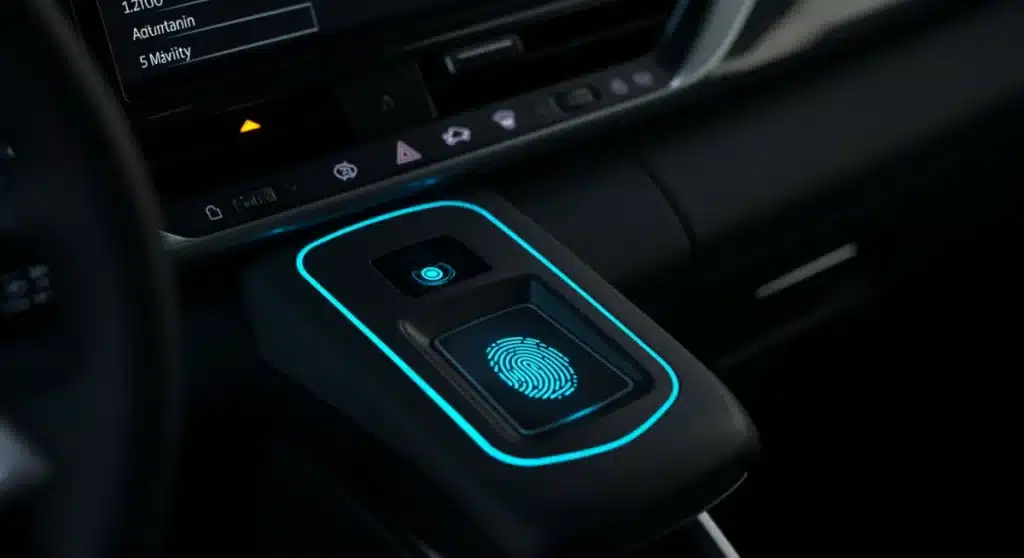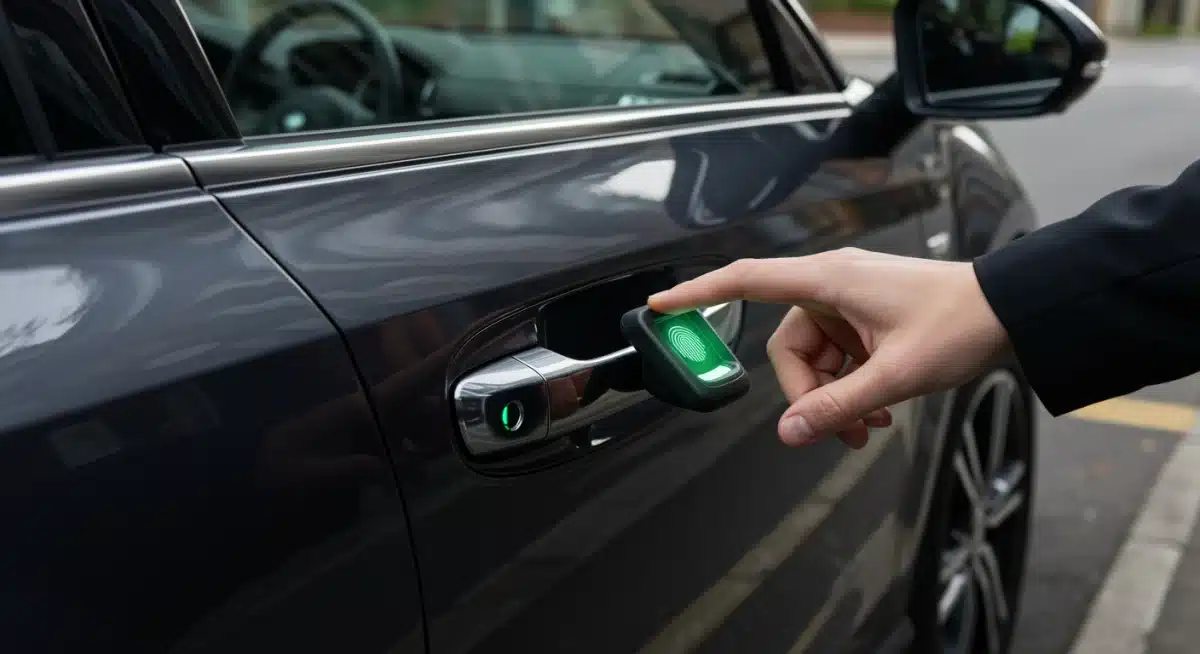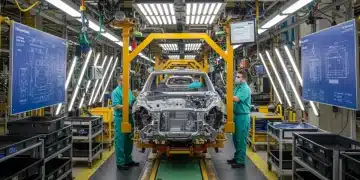Biometric Security in Vehicles: US Automotive Access & Theft Prevention by 2025

The landscape of automotive security is undergoing a profound transformation, with
biometric security in vehicles: enhancing US automotive access and theft prevention by 2025
emerging as a pivotal development. This innovative approach promises to redefine how we interact with our cars, offering
unprecedented levels of convenience and protection against unauthorized access.
The Rise of Biometric Authentication in Automotive
Biometric authentication, once confined to science fiction, is now a cornerstone of modern security, and its integration
into vehicles is rapidly accelerating. This shift is driven by the dual goals of enhancing user experience and bolstering
defenses against vehicle theft, a persistent challenge for car owners and manufacturers alike.
The adoption of biometric systems in cars is not merely an incremental upgrade; it represents a fundamental rethinking of
vehicle access and security protocols. From fingerprints to facial recognition, these technologies offer a personalized
and highly secure method of interaction with our automobiles. As of late 2023, several manufacturers are already piloting
or implementing these systems in select models, signaling a broader rollout in the coming years.
Key Biometric Technologies Emerging
Several biometric modalities are at the forefront of this automotive revolution, each offering distinct advantages.
Manufacturers are carefully evaluating these options to determine the most robust and user-friendly solutions for the
mass market.
-
Fingerprint Recognition: This is perhaps the most familiar biometric technology, commonly found in
smartphones. In vehicles, fingerprint scanners can be integrated into door handles, steering wheels, or ignition
buttons, providing quick and secure access or engine start. -
Facial Recognition: Advanced camera systems can identify authorized drivers based on their unique
facial features. This can enable hands-free entry and ignition, as well as personalize in-car settings automatically. -
Voice Recognition: While already used for infotainment, voice biometrics can extend to authenticate
drivers for critical functions, adding another layer of security and convenience. -
Iris/Retina Scans: Though less common in consumer applications due to complexity, these highly accurate
methods could see specialized use in high-end or commercial vehicles requiring extreme security.
Enhancing Vehicle Access and Personalization
Beyond just security, biometric systems are set to revolutionize the way drivers access and interact with their vehicles.
The traditional key fob, while convenient, is increasingly seen as a vulnerability and a limitation to true personalization.
With biometric access, a vehicle can recognize its authorized driver upon approach, unlocking doors, adjusting seat and
mirror positions, and even pre-setting climate control to individual preferences before the driver ever touches a button.
This level of seamless integration and personalization elevates the driving experience significantly, moving towards a
truly smart and responsive vehicle environment.
Seamless Entry and Personalized Settings
Imagine walking up to your car, and it recognizes you instantly, unlocking the doors and adjusting everything to your
liking before you even get inside. This is the promise of biometric access, eliminating the need to fumble for keys or
manually adjust settings.
-
Keyless and Fob-less Operation: Biometrics can completely replace physical keys and key fobs, reducing
the risk of loss or theft of these traditional access credentials. -
Driver Profile Recall: Each authorized driver can have a unique biometric profile linked to their
preferred seat position, mirror settings, climate control, infotainment preferences, and even driving modes. -
Multi-User Convenience: For families or shared vehicles, biometrics simplify the process of switching
drivers, as the car automatically adapts to the recognized individual.
Combating Automotive Theft with Biometric Solutions
Vehicle theft remains a significant problem across the US, costing billions annually and causing immense distress to
victims. Traditional anti-theft measures, while effective to a degree, are often circumvented by determined criminals.
Biometric security offers a robust new line of defense.
By linking vehicle operation to an individual’s unique biological traits, biometric systems make it exponentially harder
for unauthorized individuals to steal or operate a car. This fundamental shift from ‘what you have’ (a key) to ‘who you
are’ (your biometrics) creates a much more secure environment. Recent reports indicate a growing interest from insurance
companies in vehicles equipped with advanced biometric anti-theft systems, potentially leading to reduced premiums for
owners.

How Biometrics Deter Thieves
Biometric authentication introduces a level of security that is extremely difficult for thieves to bypass. Unlike keys
that can be duplicated or hot-wiring that can be performed, biometric data is unique to an individual.
-
Impossibility of Duplication: Fingerprints, facial patterns, and iris scans cannot be easily replicated
or stolen in the same way a physical key can. This makes unauthorized engine start virtually impossible without the
authorized driver present. -
Enhanced Immobilization: Even if a thief gains entry, biometric ignition systems prevent the vehicle from
starting unless the authorized driver is authenticated. This acts as a powerful immobilizer. -
Tamper Detection: Many biometric systems are designed with tamper-detection features that can alert
authorities or the owner if an attempt is made to bypass the biometric security, adding another layer of protection.
Challenges and Considerations for Widespread Adoption
While the benefits of biometric security in vehicles are clear, several challenges must be addressed for widespread
adoption by 2025. These include technological hurdles, privacy concerns, and the need for robust industry standards.
Manufacturers are actively working on these issues, investing heavily in research and development to refine the technology
and build consumer trust. The goal is to create systems that are not only secure but also reliable and intuitive for
everyday use across diverse environmental conditions.
Overcoming Obstacles to Integration
The path to ubiquitous biometric vehicle security is not without its bumps. Addressing these challenges proactively will
be key to successful implementation.
-
Accuracy and Reliability: Biometric systems must perform consistently across various conditions,
including different lighting for facial recognition or moisture on fingers for fingerprint scanners. Environmental
factors cannot compromise security or convenience. -
Data Security and Privacy: Protecting highly sensitive biometric data from breaches is paramount. Robust
encryption and secure storage protocols are essential to maintain consumer trust and comply with privacy regulations. -
Cost Implications: Integrating advanced biometric hardware and software can increase vehicle costs,
which manufacturers must balance with market demand and consumer willingness to pay for enhanced security. -
Standardization: A lack of industry-wide standards could lead to fragmentation and compatibility issues.
Collaboration among automakers and technology providers is crucial for seamless integration.
Regulatory Landscape and Consumer Acceptance
The regulatory environment surrounding biometric data and its use in consumer products is still evolving. As biometric
security in vehicles becomes more prevalent, policymakers will likely introduce new guidelines to protect consumer
privacy and ensure data integrity.
Consumer acceptance will also play a critical role. While many are comfortable with biometrics on smartphones, the idea
of their car storing and using such sensitive data may require a period of adjustment and education. Transparency from
manufacturers about how data is handled will be vital.
Navigating Privacy and Building Trust
For biometric vehicle security to gain broad acceptance, addressing privacy concerns and fostering consumer trust are
non-negotiable. Clear communication and robust safeguards are essential.
-
Data Encryption: All biometric data must be heavily encrypted, both in transit and at rest, to prevent
unauthorized access. -
Consent and Control: Users must have clear control over their biometric data, including the ability to
revoke access and understand how their data is used and stored. -
Regulatory Compliance: Manufacturers must adhere to existing and emerging data protection laws, such as
GDPR and various state-level privacy acts, when deploying biometric systems.
The Future Outlook: Biometric Integration by 2025
Looking ahead to 2025, the trajectory for biometric security in vehicles points towards significant advancement and
broader integration. Industry experts predict a notable increase in models offering biometric features as standard or
optional equipment.
The convergence of enhanced processing power, miniaturized sensors, and sophisticated AI algorithms will make these
systems more accurate, faster, and more affordable. This rapid technological evolution, coupled with a growing demand
for advanced security and convenience, positions biometrics as a defining feature of the next generation of automobiles.
Emerging Trends and Predictions
The next few years will be critical in solidifying the role of biometrics in automotive security. Several trends are
expected to shape this evolution.
-
Multi-Modal Biometrics: Expect to see systems that combine two or more biometric methods (e.g.,
fingerprint and facial recognition) for even higher security and redundancy. -
In-Cabin Monitoring: Beyond access, biometrics could be used for driver monitoring to detect fatigue or
distraction, enhancing safety. -
Integration with Smart Home/City Ecosystems: Vehicles with biometric IDs could seamlessly integrate with
smart home systems or smart city infrastructure, offering a connected experience beyond the car itself. -
Over-the-Air Updates: Biometric systems will likely be updated via over-the-air (OTA) software updates,
allowing for continuous improvement in security and functionality without dealership visits.
| Key Aspect | Impact by 2025 |
|---|---|
| Access & Convenience | Keyless entry, personalized settings, and seamless driver recognition will become common, enhancing user experience. |
| Theft Prevention | Biometric ignition and enhanced immobilizers will significantly reduce vehicle theft rates, increasing security. |
| Technology Integration | Fingerprint, facial, and voice recognition are leading modalities, with multi-modal systems gaining traction for robustness. |
| Challenges & Outlook | Privacy, data security, and standardization are key challenges, but widespread adoption and continuous innovation are expected. |
Frequently Asked Questions About Biometric Vehicle Security
Currently, fingerprint recognition, facial recognition, and voice biometrics are the primary types being integrated. These systems offer secure access, engine start, and personalized in-car settings, moving beyond traditional key fobs for enhanced convenience and protection against theft.
Biometric security prevents theft by requiring a unique biological identifier (like a fingerprint or face) to unlock doors or start the engine. This makes it extremely difficult for unauthorized individuals to operate the vehicle, as they cannot replicate or steal biometric data like a physical key.
While biometric systems are rapidly advancing, a complete replacement of traditional keys by 2025 is unlikely for all vehicles. Expect a hybrid approach where biometrics offer primary access, with traditional keys or digital keys via smartphone serving as backups or for older models.
Main privacy concerns include the secure storage and transmission of sensitive biometric data, potential for data breaches, and how this data might be used or shared. Manufacturers are focusing on robust encryption and clear consent protocols to address these concerns and build consumer trust.
Automakers are actively developing and testing biometric systems to ensure reliability across diverse weather conditions, including extreme temperatures, rain, and snow. Advancements in sensor technology and algorithms are continually improving performance, aiming for consistent and accurate operation regardless of environmental factors.
Looking Ahead
The rapid integration of biometric security in vehicles marks a pivotal moment for the automotive industry. As we approach
2025, the emphasis on seamless access, personalized experiences, and, critically, enhanced theft prevention will only
intensify. Consumers should anticipate a future where their vehicles are not just modes of transport but intelligent,
secure extensions of their digital lives. The ongoing developments in sensor technology, artificial intelligence, and
data security will continue to shape how these systems evolve, promising a more secure and convenient driving experience
for everyone.





